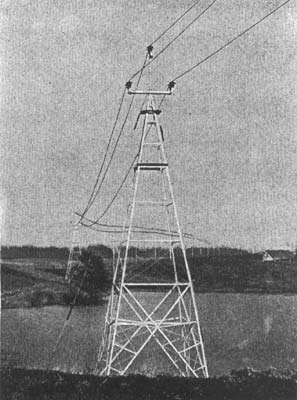[Trade Journal]
Publication: Western Electrician
Chicago, IL, United States
vol. 40, no. 3, p. 55-56, col. 3,1
The Taylors Falls Hydro-electric
Development.
As shown by previous illustrated articles in the Western Electrician (October 28, 1903, and October 20, 1906) the waterpower development on the St. Croix River at Taylors Falls, Wisconsin, about 40 miles northeast of Minneapolis, is one of the most important in the Middle West. The water power developed at St. Anthony's Falls, on the Missisippi [sic] Mississippi, has for many years been insufficient to meet the increasing demands of Minneapolis. The great growth of this city and its manufacturing industries have led to the necessity of developing additional cheap power. This need has been supplied by Stone & Webster in their development at Taylors Falls, and by means of high-tension electric transmission the power is being delivered to Minneapolis, supplying the growing needs of the Minneapolis General Electric Company. The installed capacity of the plant is 12,000 horsepower, but later this is to be increased to 24,000 horsepower.
| |||
| Transmission Line From Taylors Falls, Wis., Crossing Leedholm Lake. |
In addition to details already given in relation to this plant, the following data of the transmission line will be of interest:
The line, after leaving the station tower, immediately crosses the river to a steel tower on the Minnesota side, making a span of about 500 feet, and runs over its own right-of-way to the outskirts of Minneapolis, a distance of some 43 miles.
This right-of-way is 60 feet wide. The line construction consists of both selected cedar poles and steel towers. There is a space of seven feet between any two of the wires. Locke three-piece insulators weighing 23 pounds each are used, together with steel pins. The conductors are No. 0000 standard copper.
Transpositions of wires occur every 3 1/2 miles, a spiral of one-third of a turn being made at every such interval.
A private, telephone circuit covers the entire length of the line, with stations at regular intervals where the patrol may report to station.
At the Minneapolis end of the transmission the line enters the sub-station from a steel tower and is stepped down, through nine banks of three water-cooled transformers each, to 13,000 volts. The capacity of this station is 8,100 kilowatts, the building being of brick, steel and concrete construction.
From this sub-station the service runs, at 13,000 volts, overhead through the more open section of the city, and when well within the city limits is carried underground at the same voltage to the distributing station of the Minneapolis General Electric Company.
The old local station, which is being maintained as a reserve, contains a 1,500-kilowatt Curtis steam-turbine unit, three-phase, 60-cycle, 2,300-volt, as well as 2,360 horsepower in three turbine waterwheel units.

